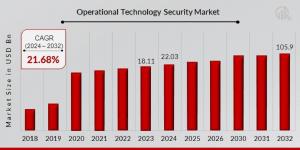Operational Technology Security Market to Reach USD 105.93 Bn by 2032 | Rising Cyber Threats to Critical Infrastructure
Operational Technology Security Market is growing rapidly industries bolster defenses against escalating cyber threats targeting critical infrastructure systems
The operational technology (OT) security market is undergoing significant transformation as industrial environments increasingly confront the reality of cyber threats. Operational technology, which encompasses the hardware and software that detect or cause changes through direct monitoring and control of physical devices, processes, and events, has traditionally operated in isolation. However, as digital transformation accelerates and industries embrace smarter, interconnected technologies, OT systems are being integrated with IT networks, making them more vulnerable to cyberattacks.
Download Sample Report (Get Full Insights in PDF - 174 Pages) at -
https://www.marketresearchfuture.com/sample_request/8189
This convergence has led to a surge in demand for specialized OT security solutions. These tools are designed to protect critical infrastructure such as manufacturing plants, power grids, oil refineries, and transportation systems from cyber threats that could disrupt operations, compromise safety, or cause economic damage. The need to secure legacy systems, ensure regulatory compliance, and maintain operational continuity is pushing organizations across sectors to reevaluate and reinforce their OT cybersecurity strategies.
The growing adoption of Industry 4.0 principles and the Industrial Internet of Things (IIoT) has dramatically increased the exposure of operational environments to cyber risks. With sensors, control systems, and automation networks being connected to enterprise IT systems and cloud platforms, threat vectors have expanded. This has created new opportunities for malicious actors to target vulnerable OT systems, often with the intent to cause physical damage or disrupt essential services.
Unlike traditional IT systems, OT environments prioritize safety, uptime, and reliability over confidentiality. This difference in operational priorities makes standard IT security approaches inadequate for OT settings. Threats such as ransomware attacks on water treatment facilities, power outages caused by malware, and breaches of SCADA (Supervisory Control and Data Acquisition) systems have become more frequent and severe. These real-world incidents underscore the importance of tailored security measures designed specifically for OT infrastructures.
Governments and industry regulators are playing a pivotal role in shaping the operational technology security market by implementing stringent cybersecurity frameworks. Regulatory mandates such as the North American Electric Reliability Corporation (NERC) Critical Infrastructure Protection (CIP) standards, the European Union’s NIS Directive, and other national security laws are compelling organizations to implement robust cybersecurity measures in OT environments.
These frameworks require industries operating critical infrastructure to assess vulnerabilities, implement protection protocols, monitor threats continuously, and report incidents promptly. Non-compliance can result in severe penalties, reputational damage, and operational disruption. As a result, organizations are investing heavily in security audits, risk assessments, and technology upgrades to align with regulatory expectations and ensure business continuity.
Technological innovations are reshaping how organizations protect their OT environments. Traditional perimeter-based defense strategies are giving way to more adaptive and intelligent security systems. Modern OT security solutions integrate AI and machine learning to detect anomalies, identify potential threats, and respond proactively before damage occurs. These intelligent systems are capable of monitoring vast amounts of data from diverse OT devices and flagging irregular behavior that could signal a cyberattack.
Buy Now Premium Research Report -
https://www.marketresearchfuture.com/checkout?currency=one_user-USD&report_id=8189
Additionally, network segmentation, zero-trust architectures, and endpoint detection and response (EDR) technologies are being increasingly adopted to isolate critical assets and prevent lateral movement of threats within networks. These technologies, when combined with real-time visibility tools and asset inventory management platforms, create a layered security approach that enhances the resilience of OT environments. The result is a shift toward proactive defense rather than reactive mitigation.
The heightened awareness of the unique risks posed to operational technology systems has led to increased collaboration between technology vendors, security providers, and industrial stakeholders. Strategic partnerships are being formed to offer integrated solutions that combine deep domain expertise in OT systems with advanced cybersecurity technologies. These collaborations are helping organizations deploy more effective and context-aware defenses tailored to their specific industrial processes.
Furthermore, industry groups and cybersecurity alliances are sharing threat intelligence and best practices to fortify collective defenses against sophisticated adversaries. Organizations are participating in tabletop exercises, red team assessments, and cross-sector cybersecurity initiatives to improve their preparedness and response capabilities. This collaborative approach is fostering a stronger and more unified OT security community, driving market momentum and innovation.
Different regions around the world are experiencing varied levels of maturity and adoption in OT cybersecurity practices. North America, driven by early adoption of digital technologies and strong regulatory frameworks, continues to lead the market. The U.S., in particular, has witnessed heightened investment in OT security following notable attacks on its critical infrastructure, such as the Colonial Pipeline incident. Government support, public-private partnerships, and sector-specific mandates are pushing organizations to enhance their OT defense mechanisms.
In Europe, the focus on cybersecurity has been reinforced by regulations like the NIS2 Directive and increased funding for cyber resilience projects. The region is also witnessing robust collaboration among industries, governments, and research institutions to develop secure-by-design technologies and ensure resilience across energy, manufacturing, and transportation sectors.
Asia-Pacific is emerging as a high-growth region for OT security, driven by rapid industrialization, the expansion of smart cities, and rising cybersecurity awareness. Countries like China, Japan, South Korea, and India are making significant investments in securing their industrial infrastructure as they modernize their production capabilities and digital ecosystems.
Despite growing awareness and advancements in technology, the implementation of OT security still faces significant challenges. Legacy systems that lack security by design continue to dominate many industrial environments, making integration of modern security solutions complex and costly. These systems often operate on outdated protocols, lack encryption, and may not support patching or software upgrades, creating vulnerabilities that are difficult to mitigate.
Another major hurdle is the organizational gap between IT and OT teams. The traditional siloed approach to managing these environments leads to misalignment in cybersecurity strategies, leaving gaps in threat detection and incident response. Bridging this gap requires cultural change, cross-training, and unified governance structures that promote collaboration and information sharing between departments.
Moreover, the shortage of skilled cybersecurity professionals with expertise in OT systems is an ongoing concern. The unique nature of industrial systems requires specialized knowledge that is in short supply. As the threat landscape evolves, organizations are under pressure to recruit and retain talent capable of managing complex OT security frameworks.
Looking ahead, the operational technology security market is poised for sustained growth as digital transformation continues to reshape industrial sectors. The increasing convergence of IT and OT, coupled with escalating cyber threats, will drive continued investment in advanced security solutions. The future of OT security lies in integrated platforms that offer centralized visibility, real-time threat intelligence, and automated incident response capabilities.
Cyber resilience will become a cornerstone of operational excellence in industrial sectors, with a strong emphasis on security-by-design principles during the development and deployment of new systems. Emerging technologies like blockchain for secure data transmission, digital twins for risk simulation, and quantum-resistant encryption for critical communications are expected to play a pivotal role in the next generation of OT security.
Browse In-depth Market Research Report (174 Pages, Charts, Tables, Figures) Operational Technology Security Market –
https://www.marketresearchfuture.com/reports/operational-technology-security-market-8189
Organizations that proactively adopt these innovations, foster internal collaboration, and engage in industry-wide partnerships will be better positioned to protect their operational assets and ensure uninterrupted service delivery. As cybersecurity becomes a boardroom priority, OT security will no longer be viewed as a technical challenge but as a strategic imperative for long-term success.
The operational technology security market is rapidly evolving in response to the changing dynamics of cyber threats and industrial digitalization. As organizations around the globe recognize the critical importance of securing their operational environments, investments in OT-specific cybersecurity solutions are accelerating. The convergence of IT and OT, coupled with regulatory pressures and technological advancements, is reshaping how industries approach cyber defense. The future of OT security lies in proactive, intelligent, and collaborative measures that safeguard infrastructure, protect communities, and support resilient economic growth. With security increasingly embedded into every layer of industrial operations, the OT security market is set to remain a vital and growing force in the global cybersecurity ecosystem.
Top Trending Reports -
Alternative Data Market -
https://www.marketresearchfuture.com/reports/alternative-data-market-11574
Telecom Outsourcing Market -
https://www.marketresearchfuture.com/reports/telecom-outsourcing-market-4272
Mobile Value-Added Services Market -
https://www.marketresearchfuture.com/reports/mobile-value-added-services-market-2969
Asset Performance Management Market -
https://www.marketresearchfuture.com/reports/asset-performance-management-market-8149
Conversational AI Market -
https://www.marketresearchfuture.com/reports/conversational-ai-market-7913
Network Slicing Market -
https://www.marketresearchfuture.com/reports/network-slicing-market-10624
Photogrammetry Software Market -
https://www.marketresearchfuture.com/reports/photogrammetry-software-market-8717
In-Game Advertising Market -
https://www.marketresearchfuture.com/reports/in-game-advertising-market-11711
Digital Content Market -
https://www.marketresearchfuture.com/reports/digital-content-market-11516
Autonomous AI and Autonomous Agents Market
India Perimeter Intrusion Detection and Prevention Market
About Market Research Future:
At Market Research Future (MRFR), we enable our customers to unravel the complexity of various industries through our Cooked Research Report (CRR), Half-Cooked Research Reports (HCRR), Raw Research Reports (3R), Continuous-Feed Research (CFR), and Market Research & Consulting Services.
MRFR team have supreme objective to provide the optimum quality market research and intelligence services to our clients. Our market research studies by products, services, technologies, applications, end users, and market players for global, regional, and country level market segments, enable our clients to see more, know more, and do more, which help to answer all their most important questions.
Contact:
Market Research Future (Part of Wantstats Research and Media Private Limited)
99 Hudson Street, 5Th Floor
New York, NY 10013
United States of America
+1 628 258 0071 (US)
+44 2035 002 764 (UK)
Email: sales@marketresearchfuture.com
Website: https://www.marketresearchfuture.com
Sagar Kadam
Market Research Future
+1 628-258-0071
email us here
Visit us on social media:
Facebook
X
LinkedIn
Legal Disclaimer:
EIN Presswire provides this news content "as is" without warranty of any kind. We do not accept any responsibility or liability for the accuracy, content, images, videos, licenses, completeness, legality, or reliability of the information contained in this article. If you have any complaints or copyright issues related to this article, kindly contact the author above.
Protection Tax Helps Clients Resolve Unfiled Returns Before IRS Action Escalates
leagend T31 Sets New Standard for Affordable and Accurate OBD II Diagnostics
Couple Opens Unique '432Hz' Live Music Sanctuary on Spain's Costa del Sol for Summer Vibes and Son Awareness
Kalendarium
Więcej ważnych informacji
 Jedynka Newserii
Jedynka Newserii

 Jedynka Newserii
Jedynka Newserii

Handel

Ze względu na różnice w cenach surowce wtórne przegrywają z pierwotnymi. To powoduje problemy branży recyklingowej
Rozporządzenie PPWR stawia ambitne cele w zakresie wykorzystania recyklatów w poszczególnych rodzajach opakowań. To będzie oznaczało wzrost popytu na materiały wtórne pochodzące z recyklingu. Obecnie problemy branży recyklingu mogą spowodować, że popyt będzie zaspokajany głównie przez import. Dziś do dobrowolnego wykorzystania recyklatów nie zachęcają przede wszystkim ceny – surowiec pierwotny można kupić taniej niż ten z recyklingu.
Przemysł spożywczy
Rośnie presja konkurencyjna na unijne rolnictwo. Bez rekompensat sytuacja rolników może się pogarszać

Rolnictwo i żywność, w tym rybołówstwo, są sektorami strategicznymi dla UE. System rolno-spożywczy, oparty na jednolitym rynku europejskim, wytwarza ponad 900 mld euro wartości dodanej. Jego konkurencyjność stoi jednak przed wieloma wyzwaniami – to przede wszystkim eksport z Ukrainy i niedługo także z krajów Mercosur, a także presja związana z oczekiwaniami konsumentów i Zielonym Ładem. Bez rekompensat rolnikom może być trudno tym wyzwaniom sprostać.
Transport
Infrastruktury ładowania elektryków przybywa w szybkim tempie. Inwestorzy jednak napotykają szereg barier

Liczba punktów ładowania samochodów elektrycznych wynosi dziś ok. 10 tys., a tempo wzrostu wynosi ok. 50 proc. r/r. Dynamika ta przez wiele miesięcy była wyższa niż wyniki samego rynku samochodów elektrycznych, na które w poprzednim roku wpływało zawieszenie rządowych dopłat do zakupu elektryka. Pierwszy kwartał br. zamknął się 22-proc. wzrostem liczby rejestracji w ujęciu rocznym, ale kwiecień przyniósł już wyraźne odbicie – o 100 proc.
Partner serwisu
Szkolenia

Akademia Newserii
Akademia Newserii to projekt, w ramach którego najlepsi polscy dziennikarze biznesowi, giełdowi oraz lifestylowi, a także szkoleniowcy z wieloletnim doświadczeniem dzielą się swoją wiedzą nt. pracy z mediami.









.gif)

 |
| |
| |
|